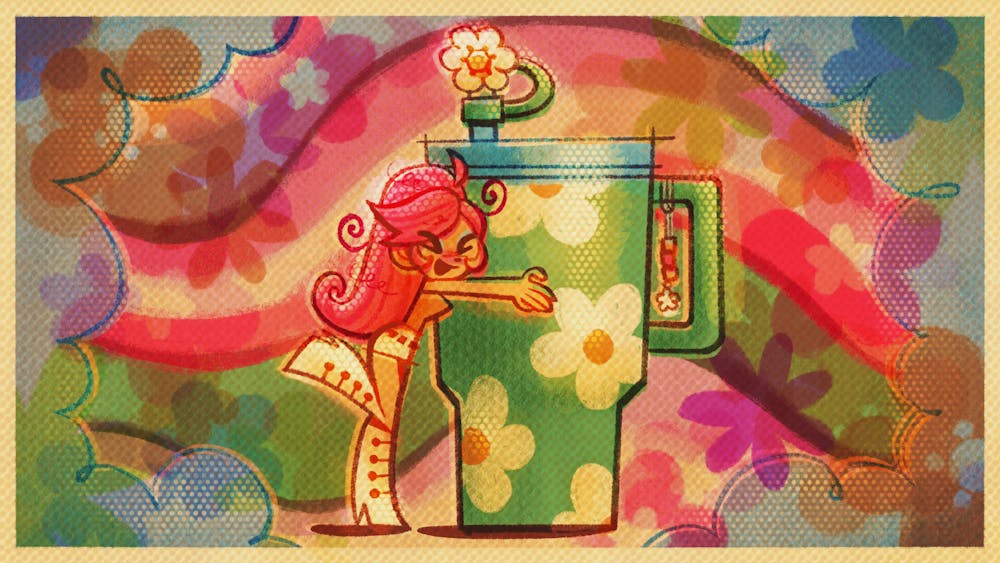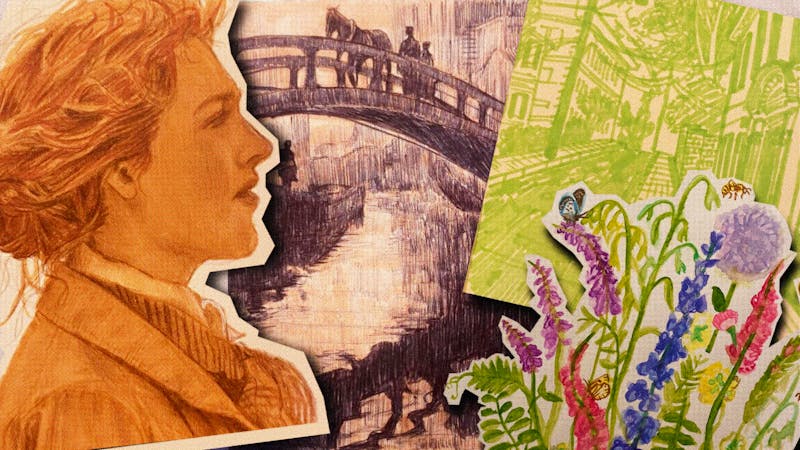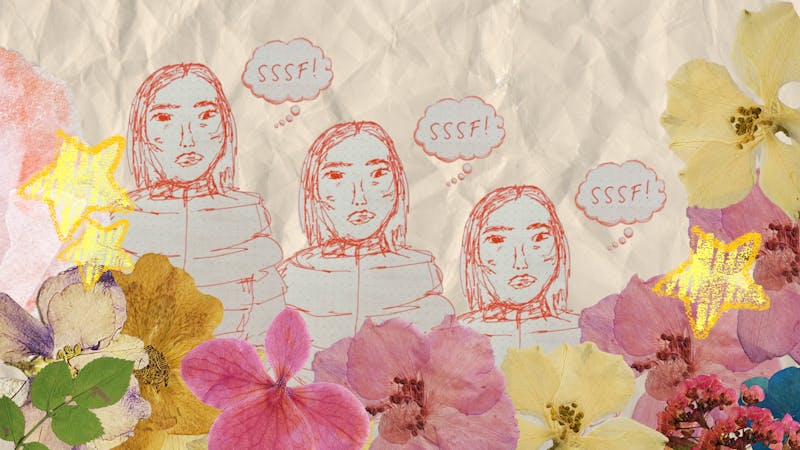My professor recently remarked that there’s only been one noticeable difference in the student body since he began teaching creative writing classes in the '70s. The only change? Students no longer gather around his seminar table, each clutching a pencil and paper copy of the last assignment. Today, they settle into their seats with laptops at the ready and water bottles within arm's reach. It’s unlikely you will sit down in a college class without your neighbor whipping out a water bottle only to place it on the table, take a sip, and leave it alone for the rest of class.
Over the last half–century, water bottles have evolved into an almost ubiquitous college accessory, or depending on who you ask, an absolute college necessity. Staying hydrated is, of course, an undeniable biological imperative. Yet, for decades, our industrialized society managed this without the water bottle—if you ever want a lecture, just ask your grandpa about whether he ever brought a water bottle to school.
But in recent decades, more and more children are grabbing water bottles before heading off to school, and adults are filling them up at the office water cooler. Where we once saw bulky water fountains in school hallways and parks, we now find sleek Elkay water bottle refill stations, some without traditional spigots to sip from, which therefore only allows users to refill their bottles. Today, you’d be remiss if you didn’t step onto a college campus and see people carrying water bottles upwards of $40.
Water bottles have become personal statements of taste and style among the newest generations, who have suckled at the teat of reusable bottles for as long as they can remember. Look no further than Tik Toks detailing the importance of beloved “emotional support water bottles,” which, like it's animal counterpart, owners bring around to every activity. For these generations, water bottles are a creature comfort and a canvas for self expression. It’s common for the majority of water bottles perched on tables in a lecture hall to be decorated with stickers, announcing the owner’s identity and interests.
Like other status symbols and luxury items, water bottles come with trends that fluctuate. Every few years, there seems to be a new “it” water bottle, advertised to be easier to use and more attractive than the last. It can be confusing to keep track of the many fluctuations of the "it'' water bottle, so, without further ado, here is Street’s comprehensive list of every "it" water bottle in the recent past.
Branded Nipple Bottle: 1990–2005
Depending on the branding, this universal water bottle could go from sporty to elementary. If you grew up on these, you remember how annoying it was when dirt would get in the textured plastic and how trashed the nipple would get after biting the tip to open it up while on the go. Still, whether it was emblazoned with Dad’s softball league’s insignia or a favorite cartoon character, almost everyone has once sipped from one.
Nalgene: 2000–2005
While it has been around since the 70s, the Nalgene gained popularity with outdoorsy adventurers in the early 2000s. Perhaps the first water bottle to be equated with a lifestyle, the Nalgene holds a special place in the hearts of hikers and the general crowd of granola types. The sight of water swirling in the clear, plastic cylinder is alluring. With use, the plastic body quickly grew scratched and cloudy, but the brand nevertheless has a cult following.
Klean Kanteen: 2005–2010
A slightly more sturdy take on the nipple bottle, the Klean Kanteen brought durability to the water bottle scene and appeased parents who were concerned about plastic chemicals. While the paint couldn’t survive more than a few runs in your dishwasher and easily dented, at the end of the day these water bottles were indestructible, and there are probably a few clunking around in your parents' pantries.
Contigo: 2010–2015
The first water bottle that would make you (or for Gen–Zers, your parents) ask, “Am I paying this much for a piece of plastic?” Yet, its leak–proof design ensured that it would hold water, whether it was rolling around in your back seat or tagging along to soccer practice. The joy of sipping from the Contigo came down to sipping from its easy to clean straw, which made you feel like you were living in paradise. After all, straws mean fancy! And, don’t worry, we won’t tell if you nibbled on the end of the rubber straw … we all did.
S’well: 2015–2019
This beloved bowling–pin–shaped water bottle had its heyday at the peak of the 2010s alongside internet challenges. Not overly sporty, outdoorsy, or preppy, it was the everyman’s water bottle. It came in 20+ patterns and could be branded with a logo or insignia, allowing for its users to express their individuality. But, for most, it went the way of the ice bucket challenge and stayed in the 2010s.
bkr Little Smooth Teddy: 2018–2022
For those who appreciated aesthetics as much as hydration, the bkr Teddy Little Bottle was a work of art. This clear water bottle encased in a pastel rubber jacket screams “I used Glossier before you did.” Literally made of glass and rather round, it wasn’t necessarily practical. However, it still has devoted fans, and you’d be remiss even today if you didn’t see one or two in your MKTG 1010 lecture.
Hydro Flask: 2019–2021
Hydro Flasks kept your drinks icy cold and became a symbol of the great outdoors … and eventually suburban high school hallways. The pride of VSCO girls everywhere, it is the first on our list to top $40. This brand became synonymous with sticker collections; it wasn’t usual to see a Hydro Flask so covered with stickers you couldn’t tell what color it was underneath all of them. A mainstay of the pandemic, this versatile water bottle has waned in the following years. Although, if you try, you can still hear the ghost of the CLANK it would have when someone would inevitably drop it on the linoleum of high school floors.
BuildLife Motivational Water Bottle: 2019–2021
Inspirational quotes met hydration with the BuildLife Motivational Water Bottle, empowering you to drink more water one slogan at a time. It was the cheerleader you never knew you needed. If you have one, it probably made the jump from a motivational Tik Tok to your Amazon shopping cart sometime during the waning days of lockdown when you promised yourself to practice self–care.
Stanley: 2020–2022
The Stanley jumped from obscurity to ubiquity over the past few years. At first the official water bottle for the clean girl aesthetic and later the vessel for the sugary “water” recipes southern moms touted on WaterTok, the Stanley has been everywhere. While its design made it perfect for car seat cupholders on road trips, its narrow base and hulking body made it difficult to fit in a backpack pouch, and they never saw a complete takeover of college campuses.
Owala: 2022–present
Owala, the new kid on the block, brings a fresh take to the water bottle game with its innovative features like an easily cleanable straw. It’s a little sporty, a little indie, and has plenty of space for stickers on its matte metal sides. While it retails for around $40, many find the price worth the satisfaction of pressing the button on the front and watching the cap spring open. Just take a glance around Locust Walk, and you’ll be sure to see one.
The reality of the constant shake up in the water bottle world is attributed to modern day buying habits. People buy new ones because their previous water bottles are lost, broken, or just because they want what is considered the “it” water bottle. One needs to look no further than Tik Tok to find hundreds of videos of people showing off water bottle collections with seemingly every color of Stanley crammed into suburban kitchen cabinets. Even what seems like comparatively modest collections beg the question of how far the goal of owning a reusable water bottle has gotten from reducing waste and limiting exposure to plastics. Not to mention, the cycle of consumption is further worsened with decorating and “customizing” water bottles. It's not only necessary to buy whatever water bottle is trending online and in several different colors, but you also need all the accessories to go with it. These excessive accessories could be tiny plastic straw covers for your Stanley (tiny Stanley, happy cloud, cowboy hats, the list goes on!) or the very necessary name tags, key chains, or water bottle straps to add to your water bottle.
In the ever–evolving landscape of personal statements and status symbols, water bottles have emerged as the go–to piece for young people. Whether adorned with stickers as expressions of identity or accessorized with the latest trends, water bottles have carved a unique niche in the realm of individuality and style. While they may raise questions about the true impact on waste reduction and sustainability, one thing is clear: Water bottle trends are firmly entrenched in our culture, reflecting a society that continually seeks to define itself. The imposed importance of water bottles on recent generations is clear, it’s what they (quite literally) put on the bargaining table.






